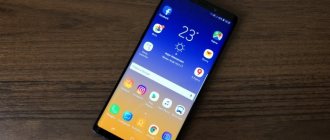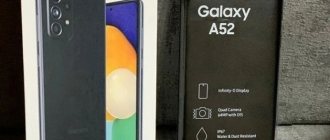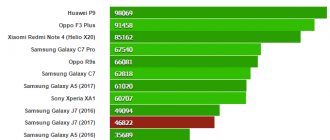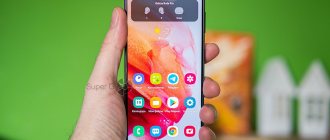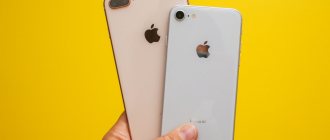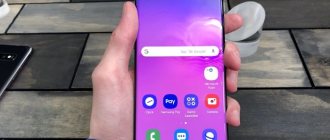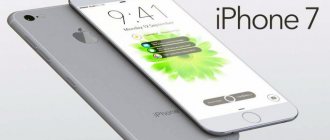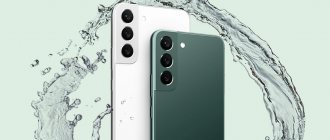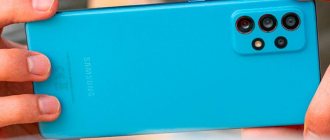Buying a copy of Samsung and Apple flagship smartphones at a price several times lower than the original is not a problem today. Of course, we became curious about what the “counterfeits” of the most advanced tubes actually are and how they work.
We have in our hands replicas of the iPhone 7 and Galaxy S7, which we will compare not only with the originals, but also with each other. Let the battle begin! Even before we begin our story, we would like to make a certain disclaimer - a written refusal of responsibility for the possible consequences of this or that action as a result of the actions of the one who declared this refusal or third parties - namely: we do not encourage you to buy replicas of famous brands, moreover, we only support original, “white” devices with a guarantee, however, denying the fact that they are sold all the time is pointless. So why not take a closer look at the replicas to see if "genuine-identical" is not what we're looking for?
Appearance
As if "iPhone"
Let's start with apple products. To begin with, we showed our colleagues two smartphones and asked them to choose the original. The votes were split roughly in half. It’s interesting that people even saw in the original what was not there, and noted the advantages of the copy, including on the button.
The external similarity of our exhibit (gold in the photo) with the original (silver) is indeed very high in all respects - from dimensions and weight to materials and assembly. The shape of the candy bar body is familiar, the components are quite high quality (the cases from the original device fit as expected).
The elements are made of high quality, the assembly does not cause any complaints: nothing creaks or plays even when squeezed. Yes, our copy is probably not protected from moisture and dust according to established standards, but we did not test this usage scenario in practice.
The dominant feature of the front panel is the 4.7-inch display. Of course, this is not Retina. The grain is visible to the naked eye (the resolution is only 1136 x 640 pixels with a density of 230 dpi), and even in the sun the picture noticeably fades.
On the bottom there is a mechanical key with Touch ID imitation and, unlike the original, it has a mechanical stroke when pressed. The upper part of the front panel is reserved for a horizontal slot for the earpiece, a proximity sensor and a front camera.
The left rounded end of the case has separated volume keys and a mute slider, while the right one is occupied by the power button and a compartment-sled for the nano-SIM.
The top end is devoid of functional elements, while on the bottom there is a Lightning connector surrounded by mounting bolts and holes for call speakers. In general, everything is like the original.
The back panel of the case is very laconic: in addition to the insert of a bitten apple and service symbols, here you can see a convex rear camera lens, a noise-canceling microphone and a flash LED.
The body of the model is expectedly non-separable, and the user does not have access to the battery.
As if "Samsung"
When turned off, our fake Galaxy S7 is quite reminiscent of its inimitable brother. Judge for yourself: it’s metal, and it really is, the frame of the case is streaked with antennas, there’s protective glass on the front, and curved dark blue glossy plastic on the back.
Upon closer examination, it becomes clear that the plastic is somewhat cheaper than the original, and there is some discrepancy in the fonts of the designations. At first glance, the assembly is of high quality, although there are small gaps between the parts, although in general there is no play or creaking.
The main element of the front panel is a large display with a thin bezel. Matrix - 5.1 inches with a resolution of 1280 x 720 pixels and a density of 290 dpi. The picture is juicy, but not ideal, and the display is expected to go blind in the sun.
At the bottom there is a multifunctional hardware key surrounded by touch-sensitive counterparts, and at the top is a speaker covered with a metal plate next to the front camera and proximity sensor.
The left side is given over to separate volume keys, and the right side is dedicated to the power button.
The upper end of the case has a hole for a noise reduction microphone and a hybrid SIM/microSD tray, and the bottom has holes for a call speaker, microphone, micro-USB and 3.5mm mini-jack. As they say, everything is in its place.
On the back panel, in addition to the above-mentioned inscriptions, there is a protruding rear camera lens, as well as a flash LED to the right of it.
The case is non-separable, which is why the user does not have direct access to the battery. The resemblance to the original S7 is extremely accurate.
Main differences from the original
The main differences between the copy and the original iPhone X include cheap materials that were used by Chinese developers to create the smartphone’s body. In addition, strong differences between the devices are found in the hardware; the MTK 6582 processor cannot be compared in terms of power and speed with the original Apple processor.
The main difference was the absence of proprietary Face ID technology, which provides great advantages when locking the phone, taking photographs, making purchases in online stores and using the Apple Pay payment system. Also big disadvantages are the lack of an original OLED screen and low-quality cameras that do not have a wide-angle lens.
Technical characteristics and delivery set
The Apple package is minimalistic: in addition to the device itself, the white and uninformative box contains a network charger, a USB cable and a clip for removing the SIM card tray.
In the black velvety Samsung box, in addition to the device itself and manuals, you will find a wall charger, a USB cable and a wired stereo headset.
| Apple iPhone 7 replica | Samsung Galaxy S7 replica | |
| Type | Smartphone | Smartphone |
| operating system | Android 4.2.2 | Android 6.0.1 |
| Display | 4.7″, 1136 x 640 pixels, 230 dpi | 5.1″, 1280 x 720 pixels, 320 dpi |
| CPU | MT6589, 2000 MHz, 4 Cortex A7 cores | MT6580, 1300 MHz, 4 Cortex A7 cores |
| RAM | 4 GB | 4 GB |
| Flash | 64 GB | 32 GB + microSD |
| Camera | Rear: 8 MP, autofocus, flash; Front: 2.1 MP | Rear: 13 MP, autofocus, flash; Front: 5 MP |
| Dimensions | 138.3 x 67.1 x 7.1 mm, 144 g | 142.4 x 69.6 x 7.9 mm, 145 g |
The hardware characteristics of smartphones were not very difficult to bring to the surface using various utilities, and the picture that presented itself to our eyes is worthy of special savoring.
Let's start with the fact that both chips are based on the ancient and slowest Cortex-A7 cores made by MediaTek.
To solve the performance problem, Apple seems to have taken extreme measures called overclocking. Otherwise, it is difficult to explain why the computing cores reach 2 GHz at their peak. The “sort of Samsung” chip, although more recent, also has four Cortex-A7 cores operating at its native frequency of 1.3 GHz. But here's a funny thing - in some cases the SoC is identified as Qualcomm Snapdragon 820, which was actually installed in some batches of the original Galaxy S7. In general, it’s as if everything is “for real”.
The second absurdity is the amount of RAM. Almost all utilities, including system help, AnTuTu and others, “talk” about 4 GB in both smartphones. But this is fake. According to MediaTek specifications, both chips support a maximum of 2 GB. And that’s exactly how much is installed in them. Moreover, of the entire set of utilities, only CPU-Z “doubted”. And it’s noticeable that the cunning Chinese in some places misled her too.
In general, both smartphones run basic software normally, but if you go beyond the limits, you start to think. Therefore, let's move on to simple tests.
Tests
And to determine the difference between them and the originals, we ran AnTuTu and GeekBench 3 tests (GeekBench 4 refused to work on them).
| iPhone 7 | "iPhone 7" | Galaxy S7 | "Galaxy S7" | |
| AnTuTu Benchmark | 130235 | 11628 | 101285 | 23487 |
| Geekbench Single-Core | 3469 | 345 | 2120 | 422 |
| Geekbench Multi-Core | 5956 | 1099 | 6438 | 1192 |
It can be seen that copies are as close to the originals as they are to heaven. In addition, “like an iPhone” is inferior to “like a Samasung”, and their results are generally consistent with the performance of these SoCs in other smartphone models, with the exception of the comprehensive AnTuTu test.
Software and interface
The software inside both handsets is, of course, Android. An open and flexible operating system is now installed in many gadgets, including televisions, so why not customize its appearance to match the shells of the brands that our guests today so skillfully repeat.
Screenshots from left to right: iPhone replica/original, Samsung replica/originalThe add-ons are made with high quality, right down to the fonts and branded features, but an inquisitive eye will be able to find various inconsistencies, and this is generally understandable: we are dealing with imitation, and not outright copying, which in general is not very possible in the logic of this OS. During the work process, there is a feeling of some carelessness in execution.
Kirei iPhone replicas
A review of a copy of iPhone 7 Plus shows that many of the functions and features of the original device are present in the system. The screen has good sensitivity and responds even to a light touch.
The main difference is the software and technical characteristics. In terms of quality, Korean copies of iPhones are not inferior to the originals and will serve you for a long time. If you do not have the finances to purchase an original device, then you can get a high-quality Chinese replica. Of course, the Korean copy of the iPhone will not be superior to the original in any way, but it fully justifies its much lower price.
Camera
The camera software, as well as the shell interface, is as close as possible to the originals. The modules themselves cannot compete with copied analogues. Their purpose is to be physically present on the body panel and to be launched from the menu.
Otherwise, we think that test footage will be much more eloquent than words. In short, the iPhone is strong in landscapes, and the Samsung is strong in macro, and that's about it.
At the top it looks like an iPhone, at the bottom it looks like a Samsung
At the top it looks like an iPhone, at the bottom it looks like a Samsung
On the left - like a Samsung, on the right - like an iPhone
At the top it looks like a Samsung, at the bottom it looks like an iPhone
At the top it looks like a Samsung, at the bottom it looks like an iPhone
Bottom line
So, before us are two extremely accurate external copies of the Apple iPhone 7 and Samsung Galaxy S7.
Software shells also copy the interfaces of the above-mentioned giants quite well. But the filling is very cheap: four Cortex-A7 cores and two gigabytes of memory. Decreasing any of these parameters by a notch would inevitably lead to noticeable slowdowns. And everything seems to work smoothly - if you don’t run resource-intensive applications. It is noteworthy that manufacturers tried to fake the filling, or rather its identifiers. Just look at the MT6580, which in one of the identification lines is described as a Qualcomm Snapdragon 820. Or two gigabytes of RAM that try to seem like four. In general, the fakes turned out to be complete, but quite working fakes. On the other hand, for the same money you can buy much higher quality and technically advanced solutions. True, they do not pretend to be famous brands.
In the comparison of fakes, Samsung won, which is better than the iPhone in almost every way.
Advantages of iPhone 7
Most users purchase a copy of the original iPhone 7 due to its stylish appearance, ease of use, and build quality. The affordable price allows you to buy it without compromising your budget.
This smartphone allows you to enjoy the benefits of an Apple device without overpaying a significant amount for it. Practical materials, memorable design and a wide range of accessories make purchasing this replica the best choice in terms of price-quality ratio.
The majority of users who bought a copy of the Iphone 7 left positive reviews on it and noted its following advantages:
- fast and reliable smartphone;
- stylish design, practical body materials;
- an exact copy of the famous gadget;
- saving budget on purchases;
- powerful processor, supports most applications and games;
- the ability to expand memory up to 64Gb with a MicroSd memory card;
- 53% discount when purchasing through the official online store;
- shooting photos and videos in HD quality;
- Gesture control, imitation of Touch ID operation;
- high-quality Russification of the interface, availability of English;
- fast delivery 1st class throughout Russia from 3 to 7 working days;
- purchase guarantee;
- payment upon receipt of the device.
Thus, buying a copy of the Iphone 7 becomes a profitable purchase when ordering through the official website this month, thanks to which you can get a smartphone with a discount of more than 50 percent.
Delivery of the device will not take much time, and paying for the smartphone only upon receipt will protect your money from scammers.
